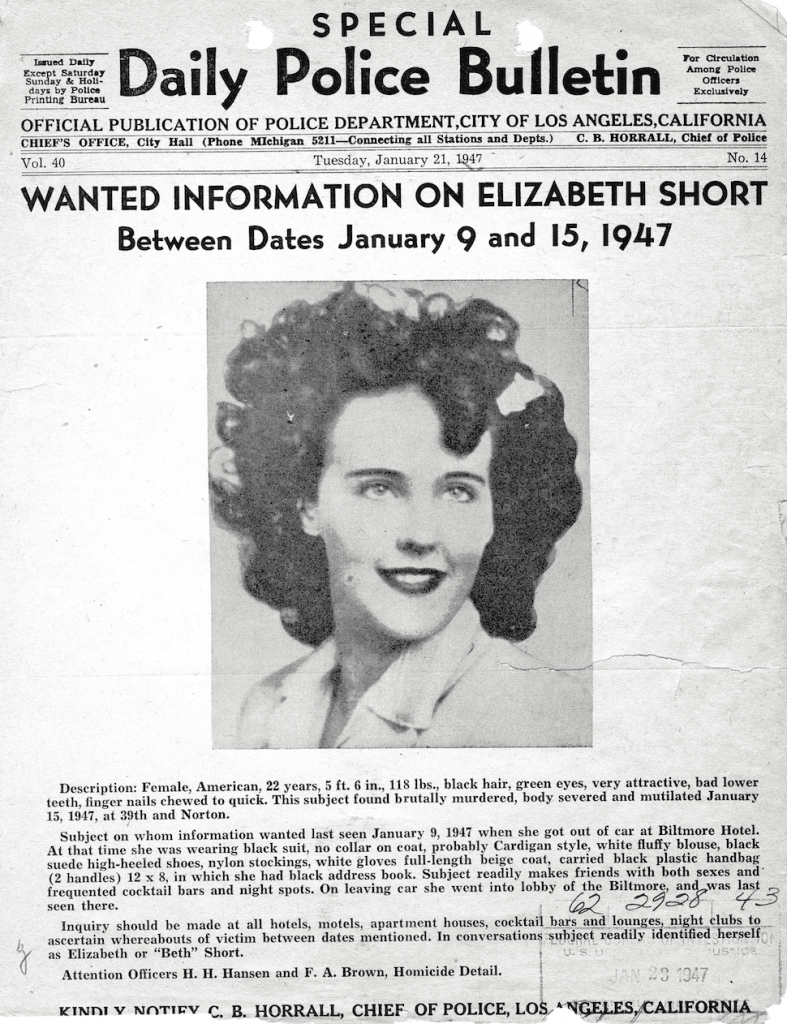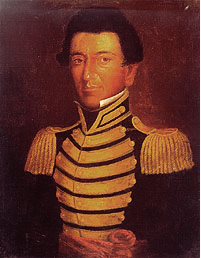Winner of the Fall 2019 StMU History Media Award for
Best Article in the Category of “Crime”
Elizabeth Short, widely known as The Black Dahlia, was a young 22-year-old American woman who was raped, brutally murdered, dismembered, and thrown on a vacant lot in a Los Angeles suburb for everyone to see. Elizabeth’s murder took place in Los Angeles County on January 15, 1947. No one knows the exact events that led to Elizabeth Short’s last moments when she fought for her life. There was no murder confession, and there was a lack of evidence to lead investigators further. Sadly, Elizabeth Short and her family never saw justice for her brutal murder. To this day, the case of The Black Dahlia is still unsolved. A man named Steve Hodel believed that The Black Dahlia murder was in fact not unsolved. Steve Hodel, a former detective, believed he had solved one of Los Angeles’ most notorious murders—but the infamous, troubled, charismatic doctor that Steve Hodel accused for being Short’s murderer, happened to be his own father, George Hodel.1
Elizabeth Short aspired to be an actress, and her young life was full of drinking and partying. She was very attracted to men and the sexual connections that came with men. Short had a desire to attend nightspots and nightclubs. Going to these nightspots, she frequently drew attention to herself, and she was arrested on September 23, 1943 for underage drinking of alcohol. She was only nineteen.2 By this time, Elizabeth had achieved a reputation as an aspiring actress who would go to bed with anyone who could possibly offer her a part in a movie.3 But her lifestyle soon led her to have a horrible encounter with a horrible man.

January 15, 1947 was just like any other day in the Los Angeles area. It was especially cool and overcast, which set the mood for the horrific discovery later that morning. A woman walking with her young daughter caught a glimpse of white flesh through a clump of brown grass in a vacant lot just a few inches from the sidewalk.4 They stumbled across the horrific sight of Elizabeth Short’s naked body cut in half just above the hipbone, drained of blood and arranged as if on display, with her legs spread and arms raised at right angles above her head. In a gruesome addition, two knife gashes extended her mouth up towards her ears.5 Her body also had the letters “B D” carved deeply into one thigh, and these letters were believed to represent the initials of Elizabeth Short’s well-known nickname Black Dahlia.6 This name stuck with her because of her tendency to always wear black clothing that contrasted with her white complexion, as well as having a dahlia flower in her hair on most occasions.7

George Hodel seemed to be an extraordinary man. He was a phenomenal doctor with a very respected reputation. Due to the extensive dismembering and perfect cuts discovered on Elizabeth’s body, her murderer had to have been a doctor.8 A couple years after the Black Dahlia murder, in 1949, Dr. Hodel’s reputation was left in tatters when he was tried for incest with his daughter Tamar Hodel, Steve Hodel’s half-sister.9 This trial brought light to George Hodel’s name in the police department. Because everyone knew that he was a very talented doctor, Dr. Hodel was put at the top of the suspect list for Elizabeth Short’s murder. Due to police corruption at the time, Dr. Hodel’s possible guilt was not presented to the public.
Dr. Hodel ended up passing away on May 16, 1999 due to a heart attack.10 Upon his passing, his son Steve Hodel began an intensive investigation into his father’s past. Steve Hodel made the trip to his father’s home to gather his father’s assets. While looking through his father’s belongings, Steve came across a tiny, palm-sized wood-bound photo album, with twelve golden fleurs-de-lys imprinted on the front.11 Inside this photo album, Steve discovered a number of strange photos of many familiar women. One of the women looked very similar to the Black Dahlia, Elizabeth Short. There were two photos of this women. In one, the woman had paper dahlia flowers in her hair. In the other, the woman was nude with her eyes shut.12 After Steve realized that the women in his father’s old photo album was the Black Dahlia, he became determined to find answers, to possibly clear his father’s name in the eyes of the law. Shortly into his private investigation, Steve Hodel realized that the evidence he was uncovering led to his father’s obvious guilt, not his exoneration. Now he wanted only to do all he could to prove it.
When Steve Hodel started the investigation into his father’s connection to the murder of the Black Dahlia, he found a substantial amount of sufficient yet circumstantial evidence against him. He soon found out that his father and Elizabeth Short knew each other. They had met in 1944 and had begun a non-sexual relationship. George would provide Elizabeth with financial aid for food and rent whenever she needed it in return for showing love interest in George. Steve’s suspicions of his father’s guilt skyrocketed when he came to find out that Elizabeth and his father were together at a downtown hotel three days before Elizabeth’s body was found. During the course of Steve Hodel’s investigation, he recognized his father’s unique handwriting multiple times, especially on the original note mailed by the Black Dahlia Avenger to the LAPD and to the press. The note with his father’s handwriting read “Here it is; Turning in Wed; Jan. 29 10 A.M.; Had my fun at police; Black Dahlia Avenger.” This was the first note that the Black Dahlia Avenger made no attempt to distort or conceal his actual handwriting.13 Hand writing analysis has since confirmed these claims. Although this evidence is circumstantial, Steve Hodel was very passionate in proving his father’s guilt. Another piece of incriminating evidence was a white-faced military watch that Dr. Hodel was seen wearing in contemporary photographs. A similar watch was found in the vacant lot close to where Elizabeth’s body was found.14
A number of men and one woman confessed to the crime, but none of them were able to match the gory details of the slaying known only by the police.15 Elizabeth’s murder seemed to bring out the worst among the psychologically disturbed in the Los Angeles area. The police were overwhelmed with the number of people who confessed to the murder.16 Despite all of these possible killers, Steve Hodel still truly believes that George Hodel was the guilty one.

The former detective for the LAPD and George Hodel’s son, Steve Hodel, had concluded his investigation on his father’s guilt, and developed an accurate timeline and detailed insight into Elizabeth Short’s last moments. Steve Hodel believes that the torture began on January 14, 1947 around 3:00-4:00 PM. Around this time, George Hodel took Elizabeth Short to the Franklin House. He gagged her mouth, bound her hands and feet with rope, and then began a prolonged and systematic process in which Elizabeth was beaten and subjected to ritualistic and sadistic torture.17 The torture included, but was not limited to the infliction of minor cuts to her body. She was beaten and kicked about her entire body, and she was forced to eat her own or his fecal excrement. Large pieces of flesh were cut from Elizabeth’s body and inserted into her orifices. Her face and breasts were also cut to imitate two of Man Ray’s famous photographs.18 Following this unimaginable torture, George Hodel then proceeded to sexually assault the then-slain Elizabeth Short.19 Although Elizabeth Short’s murderer was never convicted, it is now widely believed that George Hodel is the guilty one. The case of the Black Dahlia is considered an unsolved murder to this day, which makes it the most horrific unsolved murder in American history.20 Steve Hodel did not start his investigation until after George Hodel passed away, and only then because he passed away. George Hodel got away with his crime for over forty years. And even if he had not passed away until later in his life, face it, he still probably wouldn’t have ever been held to pay for his crime.
- Grace Bradberry, “My father was the Black Dahlia killer,” The Times, April 24, 2003. ↵
- Steve Hodel, Black Dahlia Avenger: A Genius for Murder (New York: Arcade Pub., 2003), 18. ↵
- Spectacular Crimes of the 1940s, 2007, s.v. “The Black Dahlia Case.” ↵
- Steve Hodel, Black Dahlia Avenger: A Genius for Murder (New York: Arcade Pub., 2003), 10. ↵
- Grace Bradberry, “My father was the Black Dahlia killer,” The Times, April 24, 2003. ↵
- Women in World History: A Biographical Encyclopedia, 2002, s.v. “Short,Elizabeth(1925–1947),” by Anne Commire. ↵
- Women in World History: A Biographical Encyclopedia, 2002, s.v. “Short,Elizabeth(1925–1947),” by Anne Commire. ↵
- Grace Bradberry, “My father was the Black Dahlia killer,” The Times, April 24, 2003. ↵
- Grace Bradberry, “My father was the Black Dahlia killer,” The Times, April 24, 2003. ↵
- Steve Hodel, Black Dahlia Avenger: A Genius for Murder (New York: Arcade Pub., 2003), 22. ↵
- Steve Hodel, Black Dahlia Avenger: A Genius for Murder (New York: Arcade Pub., 2003), 36. ↵
- Grace Bradberry, “My father was the Black Dahlia killer,” The Times, April 24, 2003. ↵
- Steve Hodel, Black Dahlia Avenger: A Genius for Murder (New York: Arcade Pub., 2003), 273. ↵
- Steve Hodel, Black Dahlia Avenger: A Genius for Murder (New York: Arcade Pub., 2003), 445. ↵
- Women in World History: A Biographical Encyclopedia, 2002, s.v. “Short, Elizabeth (1925–1947),” by Anne Commire. ↵
- Spectacular Crimes of the 1940s, 2007, s.v. “The Black Dahlia Case.” ↵
- Steve Hodel, Black Dahlia Avenger: A Genius for Murder (New York: Arcade Pub., 2003), 434. ↵
- Steve Hodel, Black Dahlia Avenger: A Genius for Murder (New York: Arcade Pub., 2003), 445. ↵
- Steve Hodel, Black Dahlia Avenger: A Genius for Murder (New York: Arcade Pub., 2003), 434. ↵
- Women in World History: A Biographical Encyclopedia, 2002, s.v. “Short, Elizabeth(1925–1947),” by Anne Commire. ↵



115 comments
Thalia Romo
I find the Black Dahlia case is an interesting case that always sparks my interest. I always find out new information that brings up a something interesting. I never knew that the investigator on the case, suspected the father to be a suspect. Due to the father, Dr. George Hodel, being such a phenomenal doctor and having “relations” with Elizabeth, it wouldn’t be unlikely to tie him to her murder. I enjoyed reading this article because it brings about some more information about the Black Dahlia case.
Andrea Degollado
This article is completely astonishing. I had heard about the Black Dahlia, but I didn’t exactly know about it. This article does a great job in informing the reader in what this crime was. Im honestly in shock knowing how someone could cut someone else up and be completely fine and move on with their lives. I think this is one of the most gory stories I’ve read. This article is very well written.
Briana Montes
Very interesting article to read. The article was very well written as I was reading it, I found myself being able to picture what was actually happening in the story. It was saddening that she chose the bad life like drinking and partying to become a actress. The way she was tortured was horrifying and saddening. Overall, this article was interesting.
Cristianna Tovar
I have heard about the Black Dahlia before, and as someone who is fascinated by forensics, her story is very interesting. However, the way that her body was left was disgusting and heartbreaking. I couldn’t believe that Steve Hodel suspected his own father to be the murderer but his father was never deemed guilty since the police were corrupted and he was a well-respected doctor. With numerous pieces of evidence such as George Hodel and the Black Dahlia being at a hotel three days before her body was found, nude photos of the Black Dahlia being in George’s possession, and Steve recognizing George’s handwriting in a letter to the LAPD about the murder, I am convinced that George Hodel was, in fact, the murderer. Great article!
Judy Reyes
From the beginning sentences, this is not how I expected the murder case to go. I was surprised to see that the murderer was believed to be the father of a former detective. It is absolutely terrible to read how she was cut in half, along with other wounds, as well as being raped. Her case was truly a tragedy and it saddens me that her family was never able to receive justice for her gruesome death.
Eliezer Leal
This article was very graphic, but it was interesting. I had only heard of the Black Dahlia murder by name and never fully knew what happened, and I never imagined it would be this gruesome. It’s scary to thick what a single person can do and what they are capable of. People can be very unpredictable and misleading which can make a person dangerous. Whether or not it was Dr. Holden who murdered Elizabeth short the case is still unsolved and her family with out answers.
Sydney Hardeman
This was a very interesting article. I had never heard of Elizabeth Short or George Hodel. Her murder was extremely brutal and Hodel is a prime example of how even the most well respected, savvy type of people are the ones you have to watch out for. The fact that her murder was never solved while Hodel was alive is crazy, as he got away with murder.
Nelly Perez
Being forced to eat feces is disgusting. Honestly, I wonder what went through Hodel’s mind when he was with Elizabeth. It’s sad to hear that her murder case remains unsolved to this day. Detective Hodel was right to investigate on his own to see whether or not his father was guilty of the murder. What he discovered was really shocking to him.
Alin Bocardo Felix
I was unaware of the Black Dahlia, for some reason I previously believed it was the nickname of a serial killer, but even then, reading this article is terrible. It is well written and detailed, I am Criminal Justice Major and so I was very intrigued by the process of the investigation and the murder, but I’m afraid others may find it too gory. It is surreal to even believe someone suffered through such torture, or how someone could subject another person to such torture. The Black Dahlia was a young lady living her best life, and maybe that’s why her murderer was intimidated by her free will.
Sofia Martinez
It’s very interesting and scary at the same time that George Hodel had almost 40 years without being accused, (even if he did or did not commit this horrible murder), although I did not know that there was police and federal corruption during this time, which could have been a factor as to why they never found Elizabeth’s murderer.